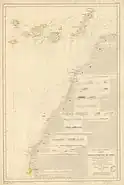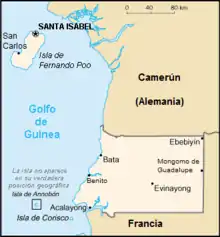Treaty of Paris (1900)
The Treaty of Paris was signed on 27 June 1900 between representatives of the Kingdom of Spain and the French Third Republic. The treaty delimited the borders of the Spanish colonies in the Sahara desert (Río de Oro, part of Spanish Sahara) and Equatorial Africa (Spanish Guinea) with respect to the adjoining French colonies on Africa.[1]
27 June 1900 | |
| Type | Bilateral treaty |
|---|---|
| Signed | 27 June 1900 |
| Location | Paris, France |
| Original signatories | |
| Ratifiers |
|
| History of Equatorial Guinea |
|---|
 |
| Chronological |
| History of Equatorial Guinea |
|---|
 |
| Chronological |
History
Based on the terms of the treaty, Río Muni was relieved of all conflicting claims. Spain was left with a mere 26,000 km2 out of the 300,000 stretching east to the Ubangi River which they initially claimed.[2] Moreover, the treaty granted the French the right to pre-emptively seize all territories if Spain decided to abandon its possessions in Río Muni.
Gallery
 Map detailing the coast of Río de Oro (part of Spanish Sahara colony) in 1896.
Map detailing the coast of Río de Oro (part of Spanish Sahara colony) in 1896..svg.png.webp) Borders raised by this treaty after 1900 of the Spanish territories of Spanish West Africa until 1956, including Río de Oro within Spanish Sahara.
Borders raised by this treaty after 1900 of the Spanish territories of Spanish West Africa until 1956, including Río de Oro within Spanish Sahara._Golfo_de_Guinea.jpg.webp) Map of Spanish possessions in the Gulf of Guinea in 1897, before the Treaty of Paris (1900).
Map of Spanish possessions in the Gulf of Guinea in 1897, before the Treaty of Paris (1900). Borders after the agreement of 1900 on the land what would become Spanish Guinea (now Equatorial Guinea).
Borders after the agreement of 1900 on the land what would become Spanish Guinea (now Equatorial Guinea).
References
- La Gaceta de Madrid, Número 89 Boletín Ordinario Publicado el sábado, 30 de marzo del 1901.
- William Gervase Clarence-Smith, 1986 "Spanish Equatorial Guinea, 1898-1940", in The Cambridge History of Africa: From 1905 to 1940 Ed. J. D. Fage, A. D. Roberts, & Roland Anthony Oliver. Cambridge: Cambridge University Press>"The Cambridge History of Africa, Volume 7~ from 1905 to 1940 (0521225051, 1986)". Archived from the original on 2014-02-20. Retrieved 2013-09-23.
External links
This article is issued from Wikipedia. The text is licensed under Creative Commons - Attribution - Sharealike. Additional terms may apply for the media files.
.svg.png.webp)
.svg.png.webp)